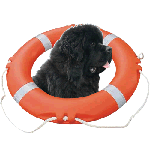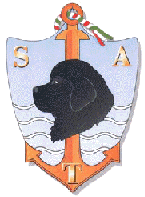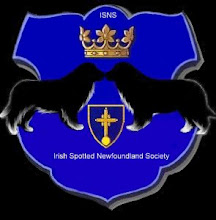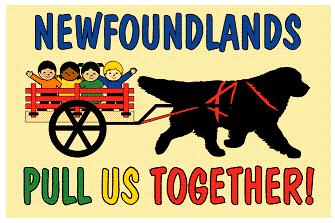Saturday, August 29, 2009
Friday, August 21, 2009
Newfoundland Saviors Hit Italy's Beaches

Canine Lifeguards Hit Italy's Beaches
(By Jeff Israely (Time.com) Thursday, Aug. 20, 2009)
The dog days of summer have hit Italy hard this year. During my family's beach holiday on the enchanting island of Sardinia, the surprise star was Totò, a pint-size, black-and-white, eight-month-old mixed-breed from Naples whom our friends brought along to a house we shared near the southern town of Pula. Totò — named for the famed Neapolitan comedian, not Dorothy's pooch — has exactly one trick in his repertoire: misbehaving. He swiped everything from pasta al pesto to a half-pound of butter off the kitchen table, ran around the yard with a neighbor's flip-flop between his teeth, and even left a summer-holiday gift on another neighbor's driveway. My attempts to get him to retrieve a Frisbee failed as soon as he realized it wasn't a pork chop.
And Totò's disobedience seemed downright spiteful when compared to that of some of the other dogs that can be found on Italy's shorelines this summer. In a program run by the National Civil Protection Agency, dozens of Labradors, Newfoundlands and golden retrievers have been trained to act as lifeguards and are now patrolling beaches and lakes around the country to help save people from drowning.
Bruno Piccinelli, head of UCIS, Italy's association of rescue-dog trainers, says the breeds, which are innately strong in the water, are trained from puppyhood until they are at least two years old to make water rescues. Dogs have long been taught to respond to specific types of water accidents and other emergencies as well as to use their keen hearing and sense of smell to assist in search-and-rescue missions — canines were used to help find survivors in the rubble of the recent earthquake in L'Aquila, for example. But now some 70 pooches have been authorized to act as Italy's Baywatch, minus the suntan lotion and shades. "Now they are on patrol," says Piccinelli.
Piccinelli, who notes that Scandinavian countries also use rescue dogs in places where lots of people gather near water, describes how the four-legged lifeguards operate: sitting up alongside their human counterparts, the dogs are trained to recognize signs of drowning. When they see someone in trouble, they paddle out to the swimmer, ideally together with their human partners, though they can also go it alone. The distressed swimmer can grab hold of the dog, which will then paddle back to safety with the rescued swimmer in tow, or the dog will drag the person in with its teeth, tugging him ashore by his arm, shirt or bathing suit. "If need be, the dogs are strong enough to pull in three people holding on to each other, or a raft with three people on it," boasts Piccinelli. Asked if these dogs could put two-legged lifeguards out of a job, Piccinelli assures Speedo-clad guardians everywhere that "they are not meant to replace human lifeguards, but to complement them."
There have been reports of this new breed of lifeguards carrying out several rescues already this summer, with local papers proudly chronicling the hairy heroics. Rambo, an 11-month-old Labrador, helped save a drowning 47-year-old bather near the east-coast city of Foggia, while Massi, a Newfoundland, and Labrador Romeo were patrolling the super-chic Amalfi coast aboard a motorized, rubber coast-guard raft when they helped two would-be victims. Other four-legged studs have offered staged demonstrations of water safety for vacationers near Venice.
As for Totò, we brought him down to Sardinia's sandy shore one evening last week, though for once we kept him tight on his leash. He spent the two hours barking and digging a hole, probably in search of something to eat. Sitting under the stars, I began to wonder whether Totò would throw himself into the surf to save someone from drowning. Of course he'd risk it all for a castaway slice of lasagna. Or a flip-flop.
Thursday, August 20, 2009
Sunday, August 16, 2009
Saturday, August 15, 2009
Gander Finally Gets His Memorial

Gander, the Royal Riflemen's best friend
The big black dog was more than a mascot to Canadians fighting in Hong Kong, Bruce Ward reports. He died defending his comrades, who made sure Gander's name was etched in stone alongside theirs.
(The Ottawa Citizen, August 15, 2009)
Gander the dauntless war dog is where he belongs now, forever beside the soldiers he served as mascot of the Royal Rifles of Canada.
You'll see Gander's name if you look closely at the Hong Kong Veterans Memorial Wall, to be unveiled today at a moving dedication ceremony. The memorial wall sits on Sussex Drive, a few blocks from Parliament Hill.
The Hong Kong vets made certain that Gander's name was etched on the memorial among the 1,975 men and two women who fought for Canada against the Japanese forces that invaded Hong Kong in December 1941.
The soldiers who lived in squalid prisoner-of-war camps after the fall of the island had one unwavering policy: they shared any food that came into their possession. In the same spirit, they wanted Gander to share in their public remembrance, a six-metre-high concrete wall encased in granite.
Gander, a massive Newfoundland dog, fought at their side and died nobly in battle. The dog seized a live grenade in its jaws and ran toward the Japanese lines. Gander died in the explosion, but saved the lives of several wounded Canadian soldiers.
The Hong Kong contingent consisted of soldiers drawn from the Quebec-based Royal Rifles and the Winnipeg Grenadiers. They were the first Canadian infantry units to see combat in the Second World War.
When he was growing up in Belledune, N.B., Andy Flanagan often heard his father, Andrew "Ando" Flanagan, speak of Gander's exploits. Ando Flanagan enlisted in the winter of 1940, and was transferred with other Royal Rifles recruits to Newfoundland. They were stationed at Botwood, near the town of Gander.
The soldiers first encountered the dog, so large it was often mistaken for a bear, while in the town, Andy Flanagan says in a memoir about his dad, which he passed on to the Citizen. The dog was called Pal, and was a great favourite among the children. But Pal got in trouble when he scratched a child's face with his paw. It was an accident; Pal was only greeting the child with his usual exuberance. Pal's owner, worried he would be forced to put down the dog, gave him to the soldiers as their mascot.
The soldiers changed his name to Gander and took the dog to heart.
"Gander quickly adapted to military life," Flanagan writes. "He was elevated to sergeant faster than any enlisted man. On parade, he proudly marched up front, wearing his sergeant's stripes next to the regimental badge, attached to his harness."
Gander accompanied the Royal Rifles when they sailed to Hong Kong in the fall of 1941. The soldiers lived well for the first few weeks. The Hong Kong dollar was worth about 18 cents Canadian, so the soldiers had plenty of cash to spend on Hong Kong's vibrant nightclub scene. Some soldiers hired Chinese servants to keep their gear and boots gleaming, and even shave them in barracks.
Gander settled in, too, and could often be found sleeping in the shade of a veranda. Some Chinese workers on the base tried to abscond with Gander in hopes of turning him into dinner, the story goes. A snarling Gander rounded on them and drove them off, adding to his status among the soldiers.
When the invasion began the day after the Pearl Harbor attack, Gander was ready to fight. "Gander showed no fear of guns or bombs," Flanagan writes. "At the battle of Lye Mun Gap, he attacked Japanese troops as they landed near the Canadian section of the beach. During the fight, one caring soldier put Gander with his wounded men for his own protection. When a few Japanese soldiers ventured too close to his wounded comrades, Gander attacked and the enemy ran away shouting 'Black devil' in Japanese.
"Later during interrogation, Ando said the Japanese asked some Canadians about the black devil. Apparently, they thought the Canadians had trained black beasts to fight in battle."
In his death, Gander became more than a mascot, Flanagan writes. "Gander became a source of pride and encouragement for the Canadians who were captured and spent almost four years in the notoriously cruel Japanese POW system. Gander was their inspiration."
In 2000, Gander was posthumously awarded the Dickin Medal, an award for "any animal displaying conspicuous gallantry and devotion to duty whilst serving with the British Commonwealth armed forces."
Gander's citation states:
"For saving the lives of Canadian infantrymen during the Battle of Lye Mun on Hong Kong Island in December, 1941. On three documented occasions, Gander, the Newfoundland mascot of the Royal Rifles of Canada, engaged the enemy as his regiment joined the Winnipeg Grenadiers, members of Battalion Headquarters 'C' Force and other Commonwealth troops in their courageous defence of the island. Twice Gander's attacks halted the enemy's advance and protected groups of wounded soldiers. In a final act of bravery the war dog was killed in action gathering a grenade. Without Gander's intervention, many more lives would have been lost in the assault."
Gander's medal is on permanent display in the Hong Kong section of the Canadian War Museum.
Ando Flanagan weighed 68 pounds when he came home in the fall of 1945. "The scars of battle and torture remained until his dying days," his son Andy writes. "He never complained, and he never missed an opportunity to tell Sergeant Gander's story. Ando faded away, without fear, on February 28, 1993."
The Ottawa Citizen
Friday, August 14, 2009
Newfoundlands Saving Italy's Swimmers


Canine Heroes Saving Italy's Swimmers
(Tom Kington guardian.co.uk, Monday 10 August 2009)
"Italy's bronzed and muscular life guards are under threat this summer as a new breed of lifesaver grows in popularity, despite being shorter and a lot hairier.
"Three hundred dogs are now licensed to save drowning bathers at Italy's beaches and lakes, and have already helped save seven lives.
"Accompanied by instructors, the labradors, newfoundlands and golden retrievers plunge through waves or even leap out of boats and helicopters to help pull bathers to safety.
"'The dogs are notching up more rescues and becoming increasingly popular', said Donatella Pasquale, vice-president of the school run by Italy's civil protection agency where dogs have trained since the 1980s.
"Pasquale said dogs learned to tow their instructors out to sea, leaving them the strength to give medical attention to drowning swimmers. 'The dogs are incredibly strong," she said. 'Our record is one Newfoundland dog towing 40 people at the same time.' They were rarely sent into the water on their own, she added. 'If you're drowning you might get a shock if a wet dog, rather than a Baywatch character, appears to save you.'
"Five of the school's graduates have debuted this year near Venice, where Marcello Monaco, a coastguard official, said they were a hit. 'They are constantly listening for yells from the water and scanning for waving arms', he said."
Wednesday, August 5, 2009
I'm Your Dog
I am your dog, and I have a little something I'd like to whisper in your ear. I know that you humans lead busy lives. Some have to work, some have children to raise. It always seems like you are running here and running there, often much too fast, often never noticing the truly grand things in life.
Look down at me now, while you sit there at your computer. See the way my dark brown eyes look at yours? They are slightly cloudy now. That comes with age. The gray hairs are beginning to ring my soft muzzle. You smile at me; I see love in your eyes. What do you see in mine? Do you see a spirit? A soul inside, who loves you as no other could in the world? A spirit that would forgive all trespasses of prior wrong doing for just a simple moment of your time?
That is all I ask. To slow down, if even for a few minutes, to be with me. So many times you have been saddened by the words you read on that screen, of others of my kind, passing. Sometimes we die young and oh so quickly, sometimes so suddenly it wrenches your heart out of your throat. Sometimes, we age so slowly before your eyes that you may not even seem to know until the very end, when we look at you with grizzled muzzles and cataract clouded eyes. Still the love is always there, even when we must take that long sleep, to run free in a distant land.
I may not be here tomorrow; I may not be here next week. Someday you will shed the water from your eyes, that humans have when deep grief fills their souls, and you will be angry at yourself that you did not have just "one more day" with me.
Because I love you so, your sorrow touches my spirit and grieves me. We have now, together. So come, sit down here next to me on the floor, and look deep into my eyes. What do you see? If you look hard and deep enough we will talk, you and I, heart to heart. Come to me not as "alpha" or as "trainer" or even "Mom or Dad". Come to me as a living soul and stroke my fur and let us look deep into one another's eyes and talk. I may tell you something about the fun of chasing a tennis ball, or I may tell you something profound about myself, or even life in general. You decided to have me in your life because you wanted a soul to share such things with. Someone very different from you, and here I am.
(Author Unknown)
Monday, August 3, 2009
Keep Michael Vick Out Of The NFL
Please click on this link and sign this petition to keep Vick out of the NFL - this vicious excuse for humanity destroyed thousands of dogs - he is being reinstated in the NFL.
This petition will go to all the companies that support the NFL.
Please send this to everyone you know - if 300 people sign it - it will be a fly in their soup - if 8 million sign it - we will get their attention.
Here is the link -
www.petitiononline.com/ridofvic/petition.html.
THANK YOU!
Alexander Bridge
SAFE HAVEN NEWFOUNDLAND RESCUE
Subscribe to:
Posts (Atom)


































